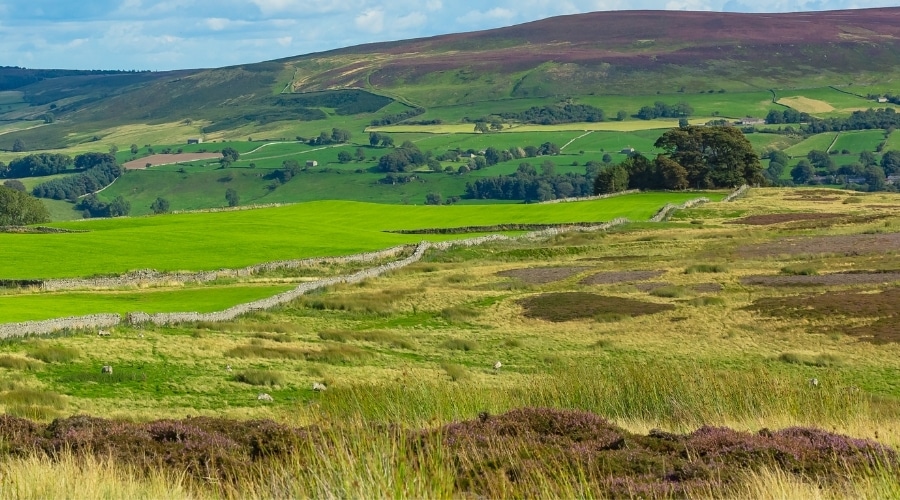No Moor Myths – the truth about grouse
- Felicity Marshall
- August 11, 2021
- 11:00 am

Myth 1: Unmanaged moors are better than moorland managed for grouse
Myth 2: Grouse moors cause flooding
Truth: Extreme weather conditions cause flooding, not grouse moor management.
Far from seeking to create drier moors, managers appreciate that when it comes to grouse moors “wetter is better”.
Flooding can be inhibited by techniques such as blocking historical drainage ditches, restoring areas of bare peat and reintroducing sphagnum mosses.
Historically, drains – or “grips” – were encouraged across upland moors in the 1960s/70s by government agricultural subsidy payments. However, grouse moor managers have been rewetting moorlandfor decades now and continue to do so.
Myth 3: Controlled burning destroys the carbon store
Truth: Research shows that controlled burning can lock in carbon as charcoal, increase the diversity of carbon-sinking sphagnum moss species, and reduce methane outputs (a climate change contributor) when compared to mowing.
Under the right circumstances, controlled burning can protect peatland and help achieve our net-zero targets.
Myth 4: Grouse are intensively reared and released on to the moors
Truth: Red grouse are truly wild birds that cannot be reared and released. They are only found in the British Isles and are closely associated with heather moorland, as heather is their primary food source.
Land management helps create a habitat where grouse, and many red- and amber-listed species, can live and reproduce.
Each year, the number of red grouse in such areas is counted and shooting only takes place if a sustainable surplus can be taken.
Myth 5: Grouse moors are causing the decline of hen harriers and other raptors in the UK
Truth: Hen harriers, and other raptors, are thriving on grouse moors. The habitat and predator control enables them to feed and breed successfully.
Myth 6: Rewilding is the answer to everything
Truth: Rewilding initiatives explore the benefits of rewetting, planting trees and addressing the climate emergency and extinction crisis. Many grouse moor managers are already tackling these issues.
The equivalent of more than 33,000 cars’ worth of carbon emissions is being removed from the atmosphere each year due to the environmental work of grouse moor estates in the north of England.
Grouse moors and their surrounding farmland are key to the survival of endangered species, including the iconic curlew, often described as the UK’s most threatened bird.
Recent news
-
BASC welcomes new Environment Secretary Steve Barclay
-
Scottish snaring ban would be “catastrophic” for threatened species
-
BASC seeks legal advice over Wales gamebird plans
-
BASC launches new deer stalking scheme in Lancashire
-
Celebrate Great British Game Week with us

Myth 7: Recent attacks on shooting have been successful
Truth: Over the last two years, challenges to lawful shooting-related practices have become more frequent and complex but not necessarily successful.
Many of the legal attacks have backfired, and sadly the countryside and wildlife have suffered as a result.
Weeks without general licences in 2019 allowed countless nests to be destroyed, crops decimated, and livestock attacked. Gulls are no longer on a general licence and are pillaging nests of amber- and red-listed species.
Far from opponents of shooting winning the argument however, a petition calling for a ban on driven grouse shooting was overwhelmingly rejected during a parliamentary debate earlier this year.
BASC’s Fighting Fund enables us to keep challenging these attacks.
Myth 8: Grouse moors are the private playgrounds of the super rich - the public aren't welcome
Myth 9: Grouse often go to waste and aren't eaten
Myth 10: Gamekeepers are just bad people
Myth 11: Wildfires are caused by gamekeepers
Myth 12: The Glorious Twelfth is just about shooting grouse
Truth: The 12th August is an iconic date which far surpasses being on a moor.
It marks the start of the annualopening of game seasons in the UK and it is an opportunity for an entire community to celebrate their hard work.
In reality, moors will start shooting at different times, for some this will be on 12 August and others much later in the season. This is because grouse management is very site-specific and affected by multiple factors.
Each year, moors count the number of grouse they have and a sustainable surplus calculated. If there are not enough red grouse to take a sustainable surplus, shooting does not take place.
Even when shooting doesn’t occur, the investment in the land, infrastructure and people is still required. On moors managed for grouse this is privately funded.
While there may only be a fraction of people involved in shooting on the Glorious Twelfth, shooters, beaters, pickers up, dogs, local businesses, and keepers will be marking the occasion in recognition of the community as a whole.
